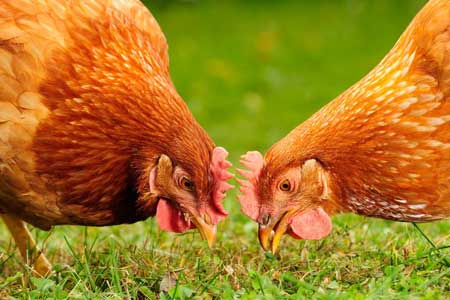
Unlike cows and sheep, chickens are not primarily grazers and cannot digest large amounts of tough fiber. Short pasture perennials are therefore more suitable than taller plants as forage for free range chickens. But, like any pasture, forage for chickens must be suitable for the climate and properly managed.
Warm Season Forage
Among warm-season greens, alfalfa is a good choice where rainfall is adequate, or irrigation is available. Lespedeza has a similar nutritional value and grows well in southern regions; in the colder north it must be seeded as an annual.
Ladino and alsike clover are other popular warm-season choices. Add a little plantain, both narrow and broad leaf, as well as chicory, and the chickens will love you for it. And don’t worry about dandelions; the chickens will take care of them for you.
Cool Season Forage
Orchard grass is a cool-season pasture grass with a broad leaf that chickens like, and it gives them an early start on spring greens. A mixture of grasses extends the season and might include perennial ryegrass, fescue, Kentucky bluegrass, Canada bluegrass, and timothy.
Any of the cereal grasses make good cool-season pasture. Oats seeded in spring grow quickly; seeded in midsummer, they offer late-summer and fall forage. Rye, wheat, and barley seeded in the fall may be grazed all winter into spring.
Managing Forage
Since chickens pluck rather than graze, the pruning action causes forage plants to tiller, or grow more stems, and consequently more grain if you let the cereal grasses go to seed. Alternatively, plant them as a garden cover crop for your chickens to graze and turn them under before they go to seed. Spelt makes a good winter cover crop that furnishes greens in early spring when little else is growing.
Plants that are in the vegetative, or growing, stage are more nutritious than tough, stemmy plants, which chickens won’t eat anyway except if they’re half starved. Unless your flock follows some other kind of livestock in a grazing rotation, during times of rapid vegetative growth — when plants grow faster than the chickens can eat them — you will have to get out the mower or Bush Hog to keep the pasture mowed down. Cutting plants short not only keeps them growing but also lets in sunlight to minimize the buildup of parasites and other infectious organisms.
Avoiding Bare Ground
Chickens tend to stay close to their shelter and can quickly overgraze an area, trample the pasture, and destroy plants by digging holes for dust baths. They are more inclined to forage widely where trees or small range shelters give them both a sense of security and a place to rest in the shade. Another way to encourage birds to venture forth is to space a few watering stations away from their shelter.
You might also scatter scratch grains on the ground, choosing a different place each day so the chickens don’t keep scratching up one area. Since foraging causes chickens to burn off extra energy, you can safely feed ranged chickens up to ¾ pound of scratch per two dozen birds.
When an area has been grazed down, or if bare spots appear, move the chickens to new ground. In doing so, you will be imitating the natural conditions under which plants grow best. In nature, a flock moves together to avoid predation, quickly grazes down an area (during which it scratches up the ground and deposits large amounts of manure), then moves on.
How long a flock takes to graze down a given area depends on a number of factors, including the size of the flock, the kind and condition of the pasture, temperature, and rainfall. When sun, rain, and warm weather combine to help plants grow quickly, a small flock might graze a given area for two weeks or more. In cool, hot, or dry weather, when plants grow slowly, the same flock may graze down the same area to nothing in a matter of days.
Soil pH
Over the years, pasture soil will increase in acidity. When soil pH drops below 5.5 as determined by a soil test, spread lime at the rate of 2 tons per acre. Then let the pasture rest to give plants time to rejuvenate and to break the cycle of parasitic worms and infectious diseases.
To optimize the benefits of forage, select a breed best suited for free ranging. By judiciously managing their forage you will not only have healthier hens, but also their eggs will be more healthful.
And that’s today’s news from the Cackle Coop.
Gail Damerow is the author of Storey’s Guide to Raising Chickens.

